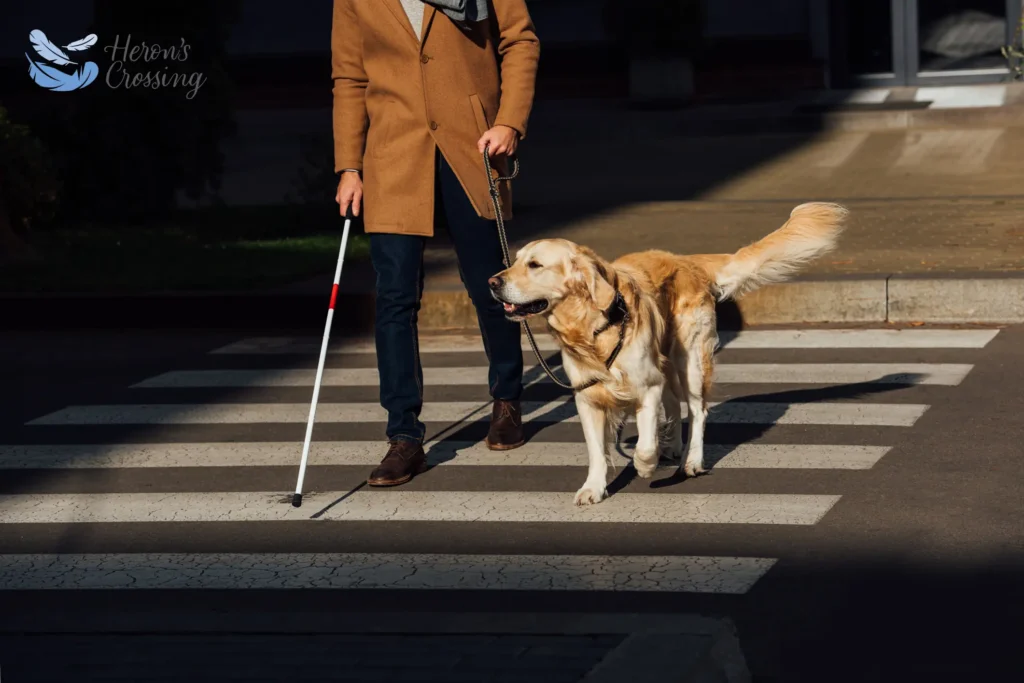Guide dogs for people who are blind or have poor vision are probably the most familiar assistance dogs of all. That’s because they’ve been faithfully serving those who are vision impaired for thousands of years.
Excavations in Pompeii show a mural of a man being led by his dog, as does a Chinese scroll from 1200 A.D. From the 1500s to the 1800s there were occasional references or depictions of dogs leading their blind owners, usually also with the aid of a walking stick, or a stick contraption attached to the dog’s collar, used for more precise interpretation of the dog’s movement. This is similar to the handle harness that many owners use today.
The first documented attempt to train an assistance dog happened around 1780 at a hospital for the blind in Paris, France, but it wasn’t until 1916 that actual schools for sight-assisting guide dogs came into being.
In 1926 a blind American, Morris Frank, contacted Dorothy Eustace, an American already breeding and training German Shepherds for police, customs and military work in Switzerland. Frank went to Switzerland to be trained with a dog of his own, and brought back the first ‘Seeing Eye’ dog — Buddy — to the US. In 1928, Frank and Buddy astounded skeptics and journalists by walking through bustling New York traffic.
Traditionally the dogs of choice in Europe have been German Shepherds, bred for their intelligence and dutifulness. However, Golden Retrievers and Labrador Retrievers are more often bred in the US, based also on their patience and empathy.
The dogs are incredibly intelligent. They are taught to think and to make split-second decisions. They will choose to disregard commands that would hurt their owner, such as crossing the street with oncoming traffic.
There are many organizations in the US that provide guide dog services for the blind, often at little or no cost, thanks in part to volunteers, outpourings of donations, and government assistance.
The first thing to check out is the American Kennel Club’s Service Dog 101 tutorial. It gives a general rundown on how a service dog is classified, because it will make a difference as far as what funding is available, as well as qualifying for special public or housing accommodations.
The AKC, working with the American Service Dog Access Coalition, is also a good source for learning about legal issues and imposters, who have proliferated because of big loopholes in the federal law, and the money that such noble charities can attract. Imposters endanger people. A falsely trained dog could falter when most needed, or become triggered in a loud public place. So proper training by a verified facility is essential.
State and local governments are closing those loopholes with their own legislation. ASDAC is also working on an optional certification program, to provide properly trained service dogs with credentials to be shown at public places or for transportation. This may become the new standard.
Both the Georgia Council of the Blind and the National Federation of the Blind have online lists of verified guide dog schools throughout the US. These websites are good starting points to get more detailed information.
Do the dogs know their owner is blind? Yes. They are keenly attuned to their owner’s response or lack of response, such as not reacting to something in front of them. Also, they can smell the owner’s anxiety or fear of venturing out, and will help to comfort the owner.
Dogs and humans have had such a tightly woven relationship for so many thousands of years that you have to wonder, was the very first guide dog trained by man, or did she see a human in need and teach him how to follow her?
Heron’s Crossing provides end-of-life care for pets in the Metro Atlanta area. In-home appointments with compassionate vets are available. If you’d prefer a home-like setting away from your home, our Decatur office is also available by appointment.

